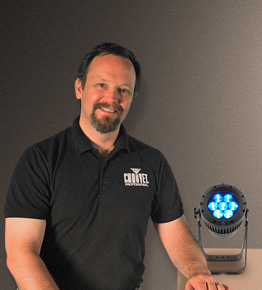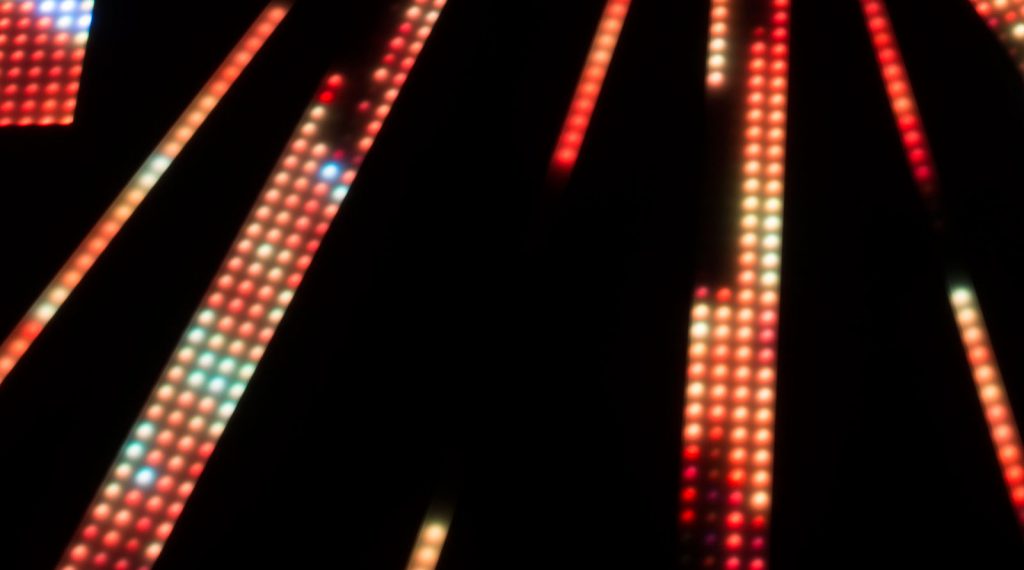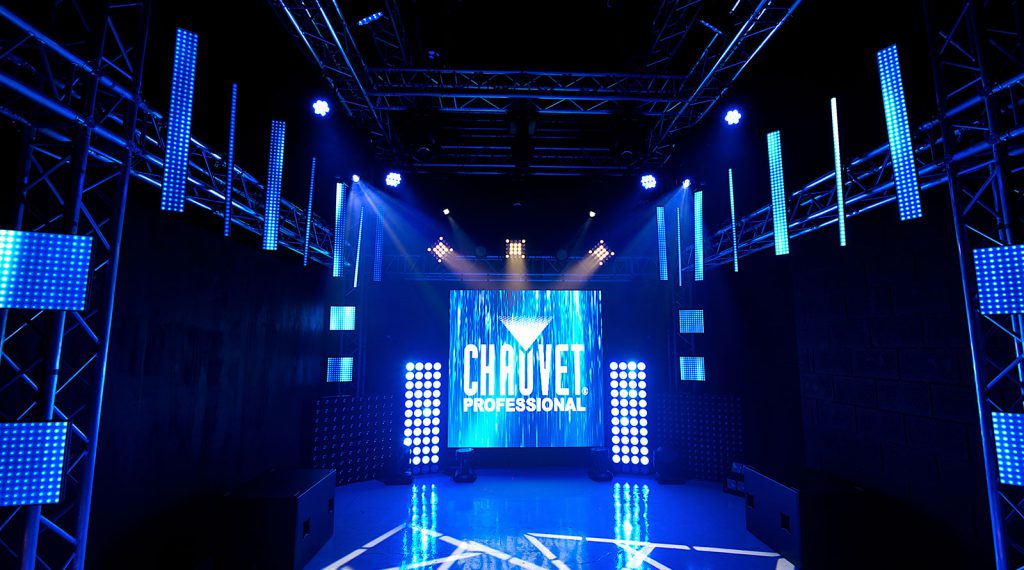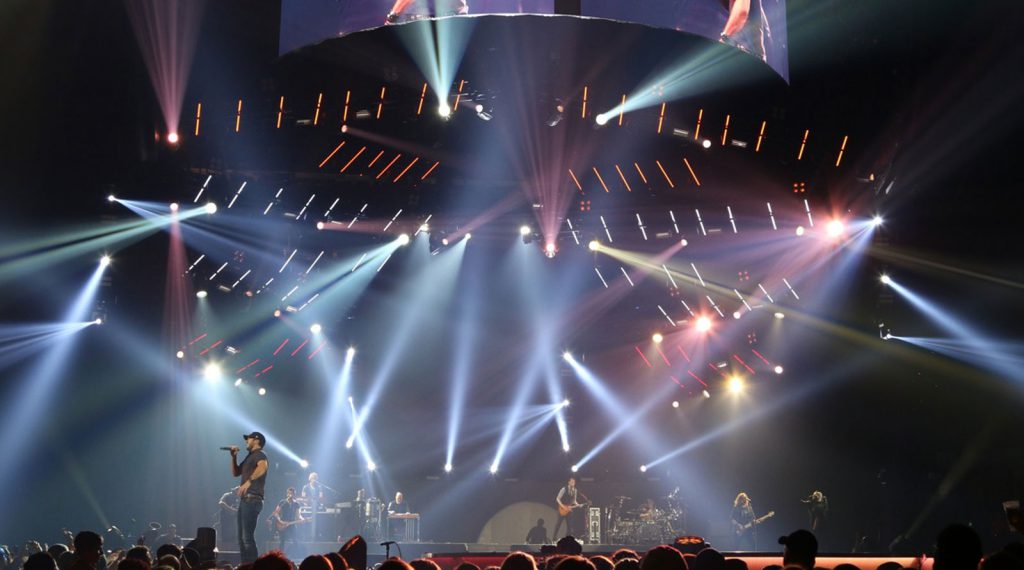Strip Center: Ford Sellers On Pixel Mapped Strip Lights
Posted on August 30, 2017Pixel mappable strip lights may have a narrow profile, but they’ve been leaving a huge footprint in a growing number of lighting designs. From framing festival stages and decorating walls to extending theatrical designs and accenting praise music during worship services, strip lights are being used in a diverse range of ways at a wider variety of applications.
 Ford Sellers, Senior Product Manager of CHAUVET Professional, strips away some of the misconceptions about these lights and offers insights into using them most effectively in your designs.
Ford Sellers, Senior Product Manager of CHAUVET Professional, strips away some of the misconceptions about these lights and offers insights into using them most effectively in your designs.
It seems that we’re seeing pixel based strip lights pop up in more and more designs – not just clubs, but also concerts, churches and even theatres. Why do you think these lights are becoming more popular?
“Pixel based strip lights open a wide range of creative options for a designer in virtually any type of application. This has always been the case, but the reason these fixtures are becoming so widely used now is availability. The technology behind the strips themselves, and – even more significantly – the control of pixel products has reached a kind of critical mass, which has helped these products become not just available, but also affordable for more designers and venues. Plus, they’ve become much easier to use as well.”
Can you elaborate on that last point? What makes them easier to use?
“Almost every mid-range lighting controller includes network (ArtNet and/or sACN) control, and most have a pixel mapper/generator built-in. In addition, manufacturers like CHAUVET Professional have been working to add features which make these more convenient to use, like the compatibility with network based protocols (sACN, ArtNet, and KlingNet), and even convenience features for the stagehands setting up the gear, like 4-Pin XLR, and interlocking housings.
“When you add other features like adjustable rigging points, multiple filter options, and pre-built effects that can be accessed with low channel counts, you have extremely flexible, user-friendly products that offer a lot of opportunities to make new and innovative designs.”

Strip lights are sometimes pixel mapped and used with video panels, any advice on coordinating the two?
“Know your products. Although it is easy to use the pre-built effects with strip lights, these products are most effective when the designer really thinks through how these lights are going to be integrated with the rest of the design. Mapping video (through a media server) to the strips, as well as various LED screens and projection surfaces is the best way to tie a multi-screen design together. For a show without video, you might want to run patterns through a pixel mapper, or match the color palette used in your stage lighting into the strips.”
There are different filters available with strip lights. Why is it important to select the right filter for a project? Can you go over the types of filters?
“Filter type is really dependent on the effect that the designer is going for. For instance, the Epix Strip IP comes with the option of direct view of the LEDs, and three separate filters. A black stealth filter, which has the fixture blend into the background when it’s off. There’s also a milky square filter that increases viewing angle and blends the pixels but keeps a very linear look, and a round cover, which creates a video tube effect.
When would you use different types of filters?
“You might use the fixture without a filter when you are looking for extremely high contrast, and brightness. This might come in handy when you’re using the product alongside outdoor rated video walls. The stealth filter is very popular for club and church installations where the designer wants the option to have the strips disappear when not in use. For instance, a lot of houses of worship like the strip light effect during their praise music, but do not want to distract during the other parts of the service. The square milky cover gives a great effect when used as part of a scenic element, where high brightness and blended output are key. The way that this filter blends the output from the LEDs makes the content very pleasing to the eye, which is fantastic for direct viewing in clubs and stages where the units are close to performers. Finally, the round cover increases both the viewing angle, and the apparent size of the strips, which is great for a lot of architectural applications.”
 From a product design standpoint, what are the key features that you want to include in any pixel strip light Chauvet offers?
From a product design standpoint, what are the key features that you want to include in any pixel strip light Chauvet offers?
“At Chauvet, we focus heavily on user experience. It is not enough to have a product that looks cool, or has a great effect. We focus on making these products easy to use for designers and programmers, as well as for the stagehands or installers who are going to set up the fixtures.
“On the control side we want to include features like the simple DMX layouts with pre-built effects for corporate event LDs, as well as full pixel by pixel control modes for designers who are using a media server for their content. We even have easily accessible test modes that show all of the fixture’s LEDs in various colors for troubleshooting, as well as for checking the fixtures back in to the rental house after an event is over.”
What about the actual physical design of the strips?
“When it comes to physical design, we look at everything from using robust and readily available 4-pin XLR connectors for the touring guys, to making the filter swaps tool free (as in the Epix Strip IP), and making sure that the driver can support enough fixtures to build an innovative display.
“For the installation guys, we make sure that the drivers can be mounted in a central location, with fixtures as far away as 300’, and we add features like a fully integrated web server in each unit for troubleshooting and managing software.
“In other words, we try to think about everyone who is going to interact with the unit, such as the audience member who will be looking at the product in action; the designer,who may push the boundaries of creativity on one show but be incredibly pressed for time on the next; the lighting technicians who are installing, troubleshooting, and taking the gear down after the shows; and the tech directors who are worrying about integrating the gear with their other video products, and fitting it all in under a reasonable budget.”
How important is brightness in strip lights? Are they supposed to be bright enough to stand up to moving fixtures? Is there anything you sacrifice when increasing brightness?
“It all comes down to application. Are you mounting your strip lights alongside video panels, or are you creating a pixel mapped display along an entire wall of a club? Strip lights are intended for direct view like video wall, but they have a slim profile, so you will not see these in direct competition with your moving heads. You’re more likely to see them as a visual display that is less imposing than video wall. Maybe they’re highlighting the scenic elements of a touring stage, or being used as the main scenic element—in any of these cases, how bright, how large, how diffuse the output is will be dictated by your application.
“Also keep in mind that because these are intended as direct view, they have very wide viewing angles. As such, their brightness is usually measured in NITs, like video wall. As a frame of reference, a typical indoor video wall has a maximum intensity anywhere from 900-1500 NITs, but is usually run at lower intensities. An outdoor video wall may need to be as bright as 4,500 NITs in order to be seen in direct sunlight. So when you’re working with the Epix systems in your lighting rig, you will make decisions about content and your filter selection based on what the environment is like, and how you’re combining them with the rest of your lighting.
“For instance, with a maximum intensity of just over 1000 NITs, the Epix Tour system is great for designs where it is working in conjunction with indoor video panels, as environmental lighting, or even as part of a set piece or focal point in a club. However, if you expect to use your fixtures on a lot of outdoor events, the Epix Strip IP’s maximum intensity of over 8600 NITs is probably more in-line with your needs. Even when it is used with the (most diffuse) round filter, the brightness of the Epix Strip IP is over 1300 NITs, which is brighter than most indoor video panels. This makes this product appropriate to use as a focal point on even the brightest of concert stages.”
 What advice do you have for LDs about dealing with the programming time involved with pixel mapped strip lights?
What advice do you have for LDs about dealing with the programming time involved with pixel mapped strip lights?
“Large scale pixel mapping projects have finally become a part of mainstream lighting designs. However, when you think about just how many channels or even universes of DMX can be chewed up by these products, the numbers are staggering. Each pixel uses three channels (one each for red, green, and blue). That means that an entire universe of DMX can be used for just 170 pixels. When you consider that each strip has 100 pixels, you can see that the channel count can easily get incredibly large. Inputting and tracking all of that data can become incredibly complex.
“Manufacturers have addressed this complexity in several ways. To begin with, we have put the processing for several units into a single drive. For example, one Epix Drive 2000 IP does all of the data conversion, and ‘thinking’ for up to 20 Epix Strip IP units. By setting the system up this way, we can make control of multiple units much less complicated. Secondly, the addressing is automatic. You simply select the auto-address feature, and the drive counts the number of units attached, and addresses them in series. Next, we have made the hardware work on several different protocols.
“Integration of sACN, ArtNet, and KlingNet in the drives means that you can use a wide variety of controllers, from simple lighting desks with no Pixel Generators, to more advanced lighting consoles like the ChamSys Compact series that have fully developed pixel generators and integrated media servers, to external media servers, to network based software solutions like Arkaos Media Master Express. The ability to use a wide variety of controller types makes control of these products much more accessible to beginners, and experienced LDs alike.
“Finally, the drive software in the Epix Drive 2000 IP allows you to simplify control in a few different ways. You can either control each LED separately (100 LEDs, using 300 channels per strip), or you can group the LEDs into groups of five LEDs per ‘pixel’ (20 sections, and 60 channels per strip), 10 LEDs (10 sections, 30 channels), 20 LEDs (five sections, 15 channels), or 50 LEDs per ‘pixel’ (two sections and only six channels per strip). This can help limit the total channel count, so even a basic controller with only a couple of universes of control can pixel map a large display. To make control of large numbers of units even easier, the drive can be set to seven channel mode, which allows for very basic control of color to the entire system, dimming, strobe, and 15 different pre-programmed effects with speed control. This mode can allow a board-op to get a very dynamic presentation from a basic controller, with very little programming time.
Any other comments or advice?
“Be creative, and have fun! Pixel effects are a great way to immerse your audience in the show. In their most obvious applications, they can be built into scenery, or used on the back wall to tie video surfaces together, but consider this…using just a few strips, you can extend the stage into and around your audience. You can use them to build really interesting visual centerpieces. You can use pixel strips to accent architectural elements, or even to build a large, hanging art installation piece where the structure is only half of the design and the second layer of creativity is in the lighting. You really are limited only by your imagination. I can’t wait to see how designers continue to push the envelope, and integrate these products into new, and groundbreaking projects.”